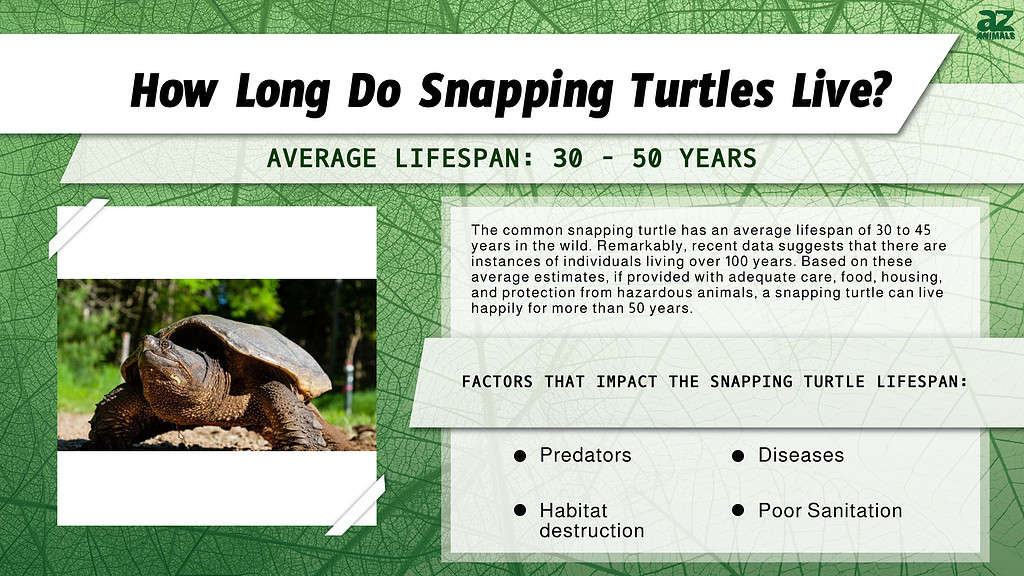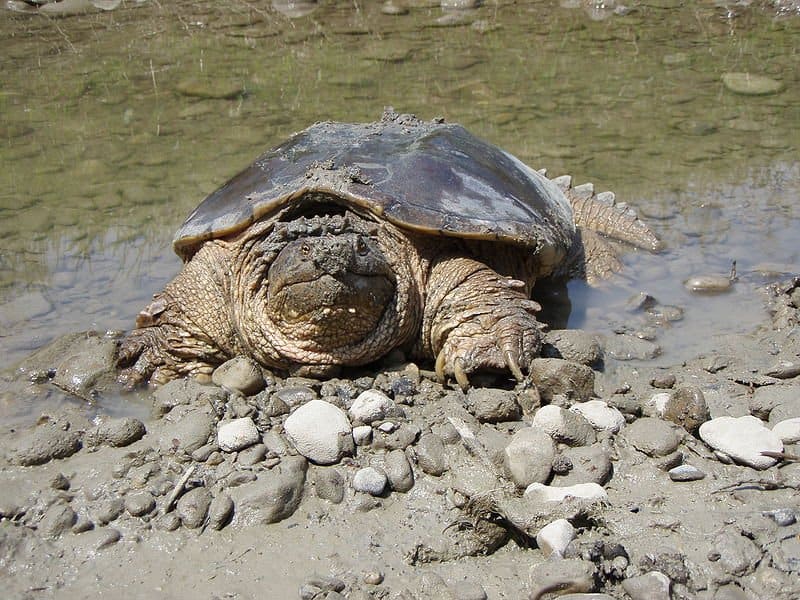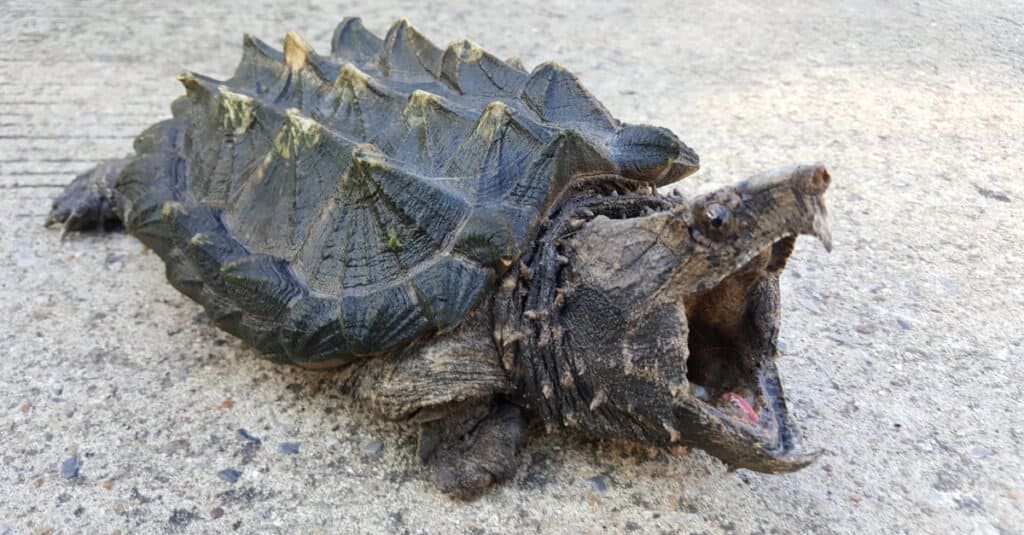
The Common Snapping Turtle is a big freshwater turtle. It has a shell that is 8-18 inches long and a tail that is as long as the shell. This big turtle is particularly known for its powerful beak-like jaws. Common snapping turtles (Chelydra serpentina) derive their name from the fact that they have a smaller bottom shell. This prevents them from hiding their massive body entirely in their shell, thus they snap when they detect danger or need to protect themselves.
Let’s have a look at some of the interesting facts about snapping turtle’s lifespan and how to keep them as an exotic pet!
How Long Do Snapping Turtles Live?

The common snapping turtle can live up to 45 years in the wild.
©Tyler Clemons/Shutterstock.com
The average lifespan of the common snapping turtle in the wild is 30-45 years. Long-term mark-recapture data from Algonquin Park in Ontario, Canada, however, show a maximum age of more than 100 years. According to all of these average estimates, as a pet, the snapping turtle will happily live in your home for more than 50 years if given proper care, food, housing, and protection from dangerous animals.
In 2016, Thunder, an alligator snapping turtle, died at the age of 150, becoming the oldest documented snapping turtle. Thunder was a resident at the Newport Aquarium, which is located near Cincinnati. Her age was determined when she was discovered in the early 1990s near a seafood market in Louisiana.
Thunder’s passion for morning yoga, according to the Aquarium’s website, was one of her unusual personality qualities. The keepers at the aquarium frequently noticed her stretching out her limbs first thing in the morning – how cute!
Now that we know the average snapping turtle lifespan, let’s explore how they mature into the adult turtles we instantly recognize!
The Average Snapping Turtle Life Cycle
Are you interested in finding out what snapping turtles undergo during each of their life stages? Because each turtle species lives in a distinct habitat, what happens in each of these life phases varies among the animals. Let’s find out all about them below!
Mating
Mating must have occurred months before fertilization in order for an egg to be created that would hatch as a snapping turtle. This normally happens between April and November, following which the female snapping turtle will start reproducing again during the warmer months.
Nesting and Laying Eggs
During the summer months, when pregnant female snapping turtles are ready to lay their eggs in the wild, they will often leave the water to dig a nest for their eggs on land. The female then digs a hole and deposits 25 to 80 eggs. She will direct them into the nest with her hind paws and cover them with sand for incubation and protection. The incubation period varies according to the temperature, ranging from 9 to 18 weeks.
Hatchlings
The hatchling snapping turtle’s life begins when it splits open the eggshell with its egg tooth. Hatchling snapping turtles are around an inch long when they emerge from the eggshell. They can have a variety of shell colors. Some hatchlings may have brown, tan, olive, or black shells.
They emerge from the shell with the egg sac still attached to their gut. The sac is generally yellowish-orange in color and includes some egg yolk, which the hatchlings will feed on until they can find nearby water in the wild.
Adulthood
When a female snapper lays eggs, the eggs hatch into hatchlings. The hatchlings then mature to sexual maturity in 4 to 7 years. This is the age when a snapping turtle is finally considered an adult. This is the final stage in the growth cycle for snapping turtles.
Factors That Impact The Snapping Turtle Lifespan

Predators like foxes and coyotes eat snapping turtles.
©Ontley – Public Domain
A variety of things determine the lifespan of a snapping turtle. These variables can decide whether a turtle lives for 40 years or for 100. Let’s look at some of the most critical aspects and how they affect the lifetime of a common snapping turtle.
Some of the most important factors include:
- Predators: Snapping turtles are most susceptible when they are in their eggs or have recently hatched. Foxes, coyotes, skunks, minks, fishers, raccoons, crows, herons, hawks, owls, bullfrogs, fish, and snakes feed on them at this stage. Adult snapping turtles have few predators due to their size. However, they are occasionally attacked by river otters, bears, and coyotes.
- Diseases: While living in captivity, snapping turtles can become sick with a number of different illnesses and diseases. Snapping turtles can get bacterial infections as a result of poor sanitation. They can also be susceptible to metabolic bone disease and vitamin deficiency both as a result of a lack of sunlight and a healthy diet.
- Habitat destruction: Snapping turtles are rapidly migrating to urban areas in the United States as their native habitats are degraded or destroyed by urbanization.
How To Extend The Lifespan Of Your Pet Snapping Turtle

Properly feeding your pet turtle would help extend its life.
©Sista Vongjintanaruks/Shutterstock.com
Snapping turtles are popular pets among a specific portion of the turtle-keeping community, despite the fact that their size and temperament make them difficult pets. However, if you’re still interested in keeping one as a pet then you’re going to want to know how to keep it happy and healthy.
These are the best tips to help extend the lifespan of your pet snapping turtle:
- Proper nutrition: Alligator snapping turtles are carnivores that feed on live fish. Try to offer a range of species, but avoid goldfish and other parasite-prone species. Common snapping turtles are omnivores that eat mostly fish and other aquatic creatures, but in the wild, they also eat aquatic plants. To replicate this food source, give your pet lush green veggies once a week.
- Adequate housing: No matter what kind of snapping turtle you adopt, you will need a large aquarium. The big enclosure not only gives the turtle more room but also keeps the water clean and makes it possible to include hiding spots and other structures in the habitat.
- Avoid holding them a lot: Snapping turtles are the type of pet that are fun to look at but not necessarily fun to interact with. Try to handle them as little as possible. Many snapping turtles become stressed when touched, and pet owners put themselves in danger by doing so.
The photo featured at the top of this post is © Sista Vongjintanaruks/Shutterstock.com
Thank you for reading! Have some feedback for us? Contact the AZ Animals editorial team.






